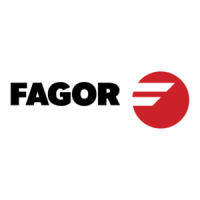Programming manual
CNC 8055
CNC 8055i
PROBING
12.
·M· & ·EN· MODELS
SOFT: V02.2X
·287·
Probing canned cycles
12.2 Probing canned cycles
The CNC offers the following probing canned cycles:
• Tool calibration canned cycle.
• Probe calibrating canned cycle.
• Surface measuring canned cycle.
• Outside corner measuring canned cycle.
• Inside corner measuring canned cycle.
• Angle measuring canned cycle.
• Corner and angle measuring canned cycle.
• Hole measuring cycle.
• Boss measuring cycle.
• Rectangular part centering canned cycle.
• Circular part centering canned cycle.
• Tabletop probe calibrating canned cycle.
All the movements of these probing canned cycles will be performed in the X, Y, Z axes and the work
plane must be formed by 2 of these axes (XY, XZ, YZ, YX, ZX, ZY). The other axis must be
perpendicular and it must be selected as the longitudinal axis.
Canned cycles will be programmed by means of the high level mnemonic, PROBE, which has the
following programming format:
(PROBE (expression), (assignment instruction),...)
This instruction PROBE calls the probing cycle indicated by means of a number or any expression
which results in a number. Besides, it allows the parameters of this cycle to be initialized with the
values required to perform it, by means of assignment instructions.
Some general points to consider
Probing canned cycles are not modal; therefore, they must be programmed every time any of them
is to be executed.
The probes used in the performance of these cycles are:
• Probe placed on a fixed position on the machine, used for calibrating tools.
• Probe placed in the spindle, will be treated as a tool and will be used in the different measuring
cycles.
The execution of a probing canned cycle does not alter the history of previous "G" functions, except
for the radius compensation functions G41 and G42.

